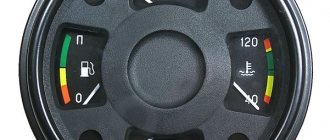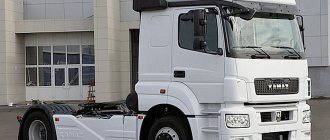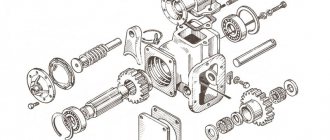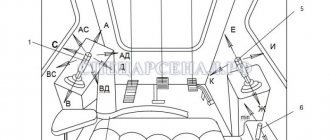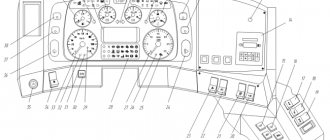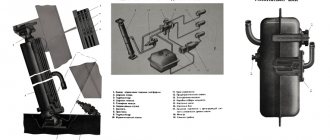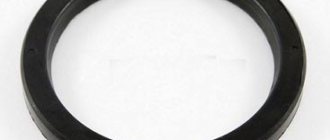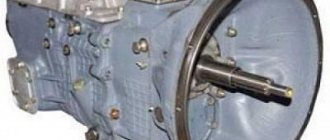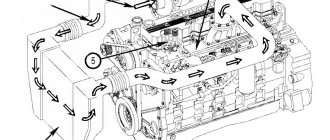Description and location of indicators and instruments on the panel
In the driver's cabin you can find many incomprehensible devices, the purpose of which must be explained for the correct operation of the vehicle. Each of these devices is located on a special panel, which folds back and is located on the left side of the panel.
The first device where the eye falls is the steering wheel. It is located in the picture below at number 6 and makes it convenient to monitor the readings that are displayed on the measuring instruments in the cockpit. Thanks to the figure below, you can find out the purpose of each button, pedal and lever that are located in the driver’s cab.
Purpose of instruments in the driver's cabin
- Auxiliary (direct) brake control button.
- The pedal is responsible for the clutch.
- A pedal responsible for controlling the brake valve.
- A pedal that controls the start of fuel.
- Air pressure distributor.
- Steering wheel.
- Windshield cleaning device.
- Window lift system lever.
- Gearbox control knob.
- Handle for closing the door.
- Handle for longitudinal movement of the passenger seat.
- Lever for adjusting the backrest of the passenger seat.
- Driver's seat suspension stiffness control lever.
- Engine cable.
- Valve handle for parking and emergency brakes.
- A device that fixes the adjustment of the backrest angle of the driver's seat.
- Fuel supply thanks to manual control.
- The handle responsible for the function of longitudinal movement of the driver's seat.
- Cabin fairing.
Instrument cluster
Below is how to diagnose problems in advance, as well as the most common breakdowns, including those due to improper use of the cigarette lighter.
KAMAZ blue
Training manual on maintenance and operation of the KamAZ-4310 army vehicle
A book on the maintenance and operation of the KamAZ-4310 army vehicle.
Hide content
- Sections Features of the device and maintenance of the KAMAZ-4310 vehicle and its modifications Purpose
- Features of the general design of the KamAZ-4310 vehicle and its modifications
- General structure, operation of the engine and its systems
- Controls and instrumentation
- Car electrical equipment
- Transmission
- Chassis
- Brake system of the Kamaz-4310 car
- Steering
- Optional equipment
- The procedure for carrying out maintenance of automotive equipment in military units
Example pages
Book information
| file size | 50 MB |
| The year of publishing | 2012 |
| Format | |
| Language | Russian |
| Pages | 109 |
| Publishing house | DOSAAF |
Link to download repair manual for army KamAZ-4310 Download
Add a comment
auto-manualy.ru
Possible malfunctions and ways to eliminate them
To ensure that no problems arise along the way, it is necessary to diagnose the system for faults before shipping.
Initially, when starting to work with this vehicle, if possible, it is necessary to carry out a quick diagnosis of systems and components. To do this, you need to light the dashboard without starting the engine. Among the indicators that light up, you need to find the lamps that are responsible for the technical condition of the battery and handbrake.
Kamaz 65115
It is also necessary to pay attention to the pressure values in the lubricant system and the glow plug fault sensor. After these simple manipulations, you can take two steps that are both easy and responsible.
- The next time you start the engine, the red indicators on the panel should go out. Only one red lamp should be on. It is responsible for the value of the handbrake. By tightening and releasing the handbrake, you can check the performance of this indicator.
- After a few seconds - from 15 to 20 - the engine can be turned off and the ignition, on the contrary, turned on. When the engine is running properly, the oil pressure indicator will not light up, which means that the pressure has risen to normal. If the engine is in good working condition, then the sensor will light up a couple of seconds after the engine is turned off. If the indicator flashes earlier or almost instantly, this is an alarming sign. Most likely, the motor is pretty worn out (the author of the video is Sergey Sergeich).
Adjusting the lifting mechanism
It is necessary to periodically check the condition and correct adjustment of the valve that limits the lift of the platform. The reliability of the valve's fastening to the subframe cross member bracket is checked. The adjustment screw must have a locknut and be locked. The bending of the stem in the valve, oil leakage from under the stem seal, and leaks along the pipeline threads are also unacceptable. With a correctly adjusted maximum lift angle of the KAMAZ platform, its locking pins should pass freely into the holes made in the subframe brackets. It is not permissible to operate a dump truck in violation of the body lift angle adjustment.
Video “Spintires - KamAZ-5320”
This review from the author of TheVostok98 is dedicated to the KAMAZ 5320 model.
1 — instrument panel; 2 — switch panel; 3 - additional panel; 4 — remote battery switch button , used to remotely turn on and off standard batteries. The control function of the remote battery switch is blocked when the key is in position “I” and “II” in the instrument and starter switch lock; 5 — hazard warning switch (for cars with engines of environmental class 4 and 5); 6 — storage box; 7 — relay and fuse compartment; 8 — glass blower deflector (on both sides), regulates the direction of the air flow of windshields and door windows; 9 — control panel for the engine pre-heater (for certain vehicle configurations with a pre-heater). 10 - control lamp block.
Instrument cluster
- warning lamps;
- fuel level indicator in the tank;
- reserve fuel indicator , lights up (color – orange) when the fuel level is less than 13% of the total volume;
- electronic speedometer;
- The speedometer indicator lights up (color – red) if the specified maximum speed of the vehicle is exceeded. The specified maximum speed is set by the vehicle manufacturer or at a service center;
- pressure indicator in the first circuit of the brake system; nominal air pressure in the pneumatic drive is from 6.5 to 8.0 kgf/cm2;
- pressure indicator in the second circuit of the brake system; nominal air pressure in the pneumatic drive is from 6.5 to 8.0 kgf/cm2;
- electronic tachometer;
- tachometer indicator - “Optimal speed” , lights up (color - green) when the car is moving at optimal engine speeds;
- tachometer indicator - “Reduced speed” , lights up (color - red) at a reduced engine speed;
- tachometer indicator - “Increased speed” , lights up (color - red) (when the permissible engine speed is exceeded);
- Coolant temperature gauge, coolant temperature under normal operating conditions:
- for KAMAZ engines from 80 to 100 ºС;
- for Cummins engines from 71 to 100 ºС;
- emergency temperature indicator , lights up (color – red) when the coolant temperature is too high;
- monitor. The monitor displays information about the operating condition of the vehicle, malfunctions or warning information;
- 16. buttons . Using the buttons, you navigate through the monitor's menu system.
Warning lamps
| Emergency oil pressure in the engine lubrication system (color – red) | ||
| Turning on the high beam headlights (color – blue) | ||
| Activation of the parking brake system (color – red, intermittent) | ||
| Emergency (color – red) | ||
| Low battery (color – red) | ||
| Trailer/semi-trailer direction indicator (color – green, intermittent) | ||
| Vehicle turn signal to the right (color – green, intermittent) | Depending on the vehicle's equipment, the left/right turn indicator lamps may light up simultaneously | |
| Vehicle left turn indicator (color – green, intermittent) | Depending on the vehicle's equipment, the left/right turn indicator lamps may light up simultaneously | |
| Turning on the center differential lock (color – orange). Not available for 4x4 vehicles | ||
| Turning on the cross-axle differential lock on the 2nd axle (color – orange) | ||
| Turning on the cross-axle differential lock for the 3rd axle (color – orange) | ||
| PTO activation (color – green) | ||
| PTO activation (color – green) | ||
| Turning on the traction control system (color - orange) | ||
| Tractor ABS malfunction (color – orange) | ||
| Trailer/semi-trailer ABS malfunction (color – orange) | ||
| Turning on the transfer case center differential lock (color – orange) | ||
| Malfunction in the engine management system (color - orange) | ||
| Malfunction in the exhaust gas aftertreatment system and/or engine (color - orange) | ||
| ECU readiness (for KAMAZ engine) or control lamp of electric intake air heater (for Cummins engine) (color - orange) | ||
| Air filter clogged (color – red) | ||
| The cabin is not locked with a hydraulic lock (color – red) | ||
| Turning on cruise control (color - green) | ||
| Brake system malfunction (color – red) | ||
| Turning on the low range in the range multiplier (color - orange) | ||
| Turning on fuel heating in the FGOT and fuel intake (color - orange) | ||
| Turning on the transfer case downshift (color – red) | ||
| Turning off the fan clutch drive (color - orange) | ||
| Turning on the retarder/intarder (color – orange) | ||
| Low liquid level in the neutralization system (color – blue) | ||
| Presence of water in the fuel coarse filter (color – red) | ||
| Low coolant level (color - orange) (for certain trim levels) | ||
Attention! The number of warning lamps depends on the specific model and configuration of the vehicle.
KAMAZ gearbox provides indication:
- vehicle speed;
- engine rotation speed;
- fuel level;
- coolant temperature;
- air pressure in circuit 1;
- air pressure in circuit 2;
b) using the parameter monitor:
- total mileage;
- daily mileage;
- urea level;
- engine oil pressure;
- coolant temperature;
- transmission oil temperature;
- on-board network voltage;
- engine operating hours;
- fuel consumption per 100 km;
- fuel consumption per 1 hour;
- number of pulses;
- vehicle speed;
- engine oil level;
Appearance
The KamAZ-44108 vehicle received an updated radiator grille, built-in fairings on the sides, as well as new doors, rear-view mirrors, and plastic handles. The domestic truck is equipped with a molded aerodynamic plastic bumper, which replaced the familiar metal bumper.
The machine is equipped with updated lighting elements. Head optics, direction indicators and side lights are integrated into a single unit. The rear-view mirrors have undergone significant modifications, the design of the fixing brackets has been changed, and additional spherical mirrors have been installed. The car's solid windshield is cleaned by a three-blade wiper, which improves visibility by increasing the surface area to be cleaned. In addition, external changes included a long cabin with a sleeping bag, suspended steps, additional fuel tanks, and single-pitch tires.


